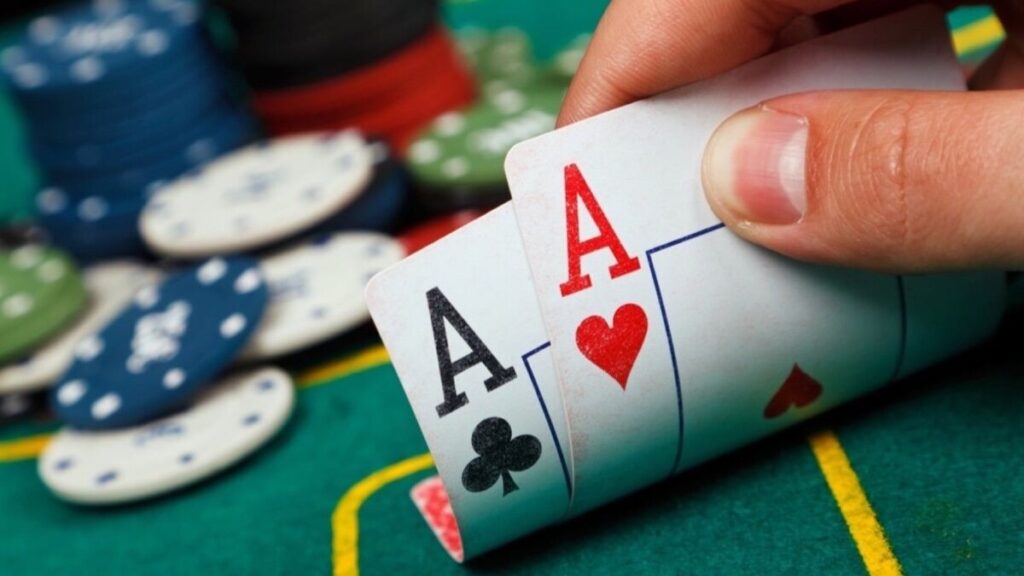There are many popular modern card games, and then there’s Poker. It has kept its fans for centuries, thanks to its simple rules and the ability to increase your chances of winning through psychology. But before you test your luck at the table, it’s important to understand the rules. So, let’s learn Poker: how do you play it with all its nuances in mind?
Basic actions at the Poker table
Playing Poker involves players placing bets before each round. This refers to the blinds (small and big). Typically, the small blind is half the size of the big blind. This approach is necessary to ensure that participants have the motivation to play. The blind sizes in a cash game are determined by the limit chosen at the table. Thanks to the contributions of each participant, there is always money in the pot.
Once the bets are placed, players are dealt a pair of cards face down, hidden from all other players. The rules of classic Poker allow for several actions during the game. Let’s discuss some of the most popular ones:
- Fold. Essentially synonymous with “pass.”The player decides not to compete for the pot, neither calling nor raising the bets. In this situation, you discard your cards and become merely an observer for the rest of the round. To determine the Poker winner, the rules eliminate players who have folded from the hand.
- Check. If there have been no previous bets in this round, you can continue playing without adding to the pot. This passes the action to the next player without cost. You’re not giving up on winning, but you’re saving money by not raising the bet. This move demonstrates a strategy of gambling with minimal expenditure.
- Bet: If no bets have been made in the current round, a player can place one. This sets a limit for other players to continue in the round. The other players must then decide how to proceed: either fold, call the bet, or raise. Poker card rules require that the bet be at least the size of the big blind.
- Call. If a bet has already been made, you need to match it. By calling, you add chips to the pot equal to the previous player’s bet.
- Raise. Increasing the current bet in the round. By doing so, you add more chips to the pot than the previous player. The others must either fold, call the raise, or re-raise. No-limit Hold’em Poker does not restrict the number or size of raises.
We’ve covered the basic Poker rules, but there are many other nuances to be aware of in this game.
Rounds and dealing cards in Poker
There are several stages of betting during the game. In classic Texas Hold’em, the rules include four rounds of raising/extending the bet:
- pre-flop – without revealing any cards;
- flop – when the first card is revealed;
- turn – two cards are revealed;
- river – the entire board is known.
These stages are referred to as “streets.” The action in each round starts with the player to the left of the last player who made a move. Once everyone has taken their turn, the hand either concludes or continues. Let’s go into more detail about each “street.”

Pre-flop
After the hole cards are dealt, each player makes an individual decision on how to proceed — whether to fold or continue playing. If they choose to stay in, they can raise the bet by an amount equal to one or two blinds. The first player to set the tone for the round is the one sitting to the left of the big blind. Then, the action moves clockwise. If no one raises during the pre-flop, the next round begins. However, if the betting limits are increased, the remaining players must also take action. At the end of this round, all bets are added to the pot, which will be awarded to the winner of the subsequent rounds.
Flop
The rules dictate that this round begins immediately after the pre-flop. Three cards, known as the “flop,” are dealt on the table. All players can see these cards, and they then analyze their existing and potential combinations. On this “street,” the first player to act is the one sitting to the left of the “button.” The final action goes to the “button.” Players can make the same moves as in the pre-flop.But now they have the additional option to “check,” allowing them to stay in the game without adding more money to the pot. Once everyone has made their move, the accumulated bets are added to the pot.
Turn
After the flop, classic Poker rules allow the game to proceed to the turn. A fourth community card is dealt face-up on the table. Players analyze the cards, and a new betting round begins. The first player to act is the one sitting to the left of the competitor on the button. With four community cards on the table, players can make more informed decisions about whether to continue in this and subsequent rounds.
River
The classic rules of Poker state that the final “street” begins with the appearance of the last, fifth community card on the table. At this point, each player understands their potential combinations and their chances of winning. The last betting round takes place. The sequence and rules of action being the same as in the flop and turn. All the bets from this round are added to the pot, after which the players compete for the main prize.
Mandatory bets: big and small blind
To create a high level of motivation in Poker, players make a small initial contribution to the common pot. This mandatory pre-round bet is called a blind. For those who love the thrill of gambling, it serves as an incentive to win back the money they’ve put in while also forming the initial pot. The small blind and the big blind differ by a factor of two. And the minimum bet increases accordingly in subsequent rounds.
Why blinds are necessary in the game

Poker rules require a mandatory bet before the cards are dealt. The player to the left of the button must post the small blind. And the next player has to post the big blind. The initial bet discourages players with weak cards from immediately folding without losing money. Without it, many would prefer to compete for the pot only when holding kings, aces, or winning combinations.
Poker hand combinations
There are over 1,300 possible combinations in classic Poker, but only a few offer a real chance of winning. Beginners should learn different strategies and combinations to increase their chances of success. Understanding the key winning hands is essential. To explain professional Poker rules in simple terms, here’s a table of the main combinations:
| Name | Example | Chance |
| High card | No combinations or matching cards, high card in hand (Ace, King, Queen…) | 17,4% |
| Pair | Two cards of the same rank (J♠J♥-7-5-Q). Pair of Jacks | 43,8% |
| Two pair | Two pairs, each of a different rank. 9♠9♥3♣Q♦Q♠ | 23,5% |
| Three-of-a-kind (set, trips) | 9♠5♥9♣Q♦A♠ Set and trips differ only in how they are formed | 4,83% |
| Straight | 7♣8♠9♦10♠J♥ Consecutive cards of different suits | 4,619% |
| Flush | A♠J♠K♠5♠2♠ Five cards of the same suit | 3,025 |
| Full House | 8♥8♦8♣5♠5♦ A pair and three-of-a-kind simultaneously | 2,6% |
| Four of a kind | K♠K♥K♦K♠J♦ Four cards of different suits but the same rank | 0,168% |
| Straight Flush | 8♥9♥10♥J♥Q♥ Five cards of similar sequence and suit | 0,028% |
| Royal Flush | 10♦J♦Q♦K♦A♦ Five highest cards of the same suit in sequence | 0,003% |
It’s impossible for beginners to learn the rules of Poker without knowing the basic winning combinations. On our website, you can study Poker hands in detail to better understand your chances of winning and know when it’s appropriate to fold or raise.
Texas Hold’em rules
If you’ve chosen to play Texas Hold’em, the rules are straightforward. Here’s a simple breakdown:
- All players make an initial bet (ante).
- Mandatory bets are made by the two blinds.
- Players are dealt two cards face down.
- The next round begins with the player to the left of the big blind.
- Three community cards are dealt face-up for everyone to use.
- The round (street) of betting, known as the flop, begins when players take turns making their moves.
- Another card is dealt face-up.
- The third round of betting (turn) takes place.
- A fifth card (river) is dealt, completing the round.
- The final betting round occurs.
- After all players reveal their hands, the showdown determines the winner, who takes the pot with the best combination.
Knowing the details will help you recognize when it’s better to fold and when you have a chance to win the pot.
Online Poker rule
Playing Poker online largely mirrors the standard card game setup in a casino. It typically involves 2-10 players. During an online Poker game, each player is dealt two cards. Then, the betting begins, which happens in several stages. Before the “streets” start, two players to the dealer’s left must place mandatory bets (small and big blinds).
For beginners, it’s recommended to secure a good position to avoid losing money right away and to observe the actions of other players carefully. During the betting rounds, you need to choose one of the available actions (bet, call, raise, fold, check). They were described earlier. The betting round ends when all players have taken their turn or returned their cards to the dealer. After each betting round, one community card is dealt (flop, turn, river).
After a round of Poker, the rules require determining who wins the pot. The final result consists of five community cards and the two hidden cards each player holds. At the end of the last betting round, the players’ hands are revealed. The winner is decided based on who has the best combination. We’ve detailed the nuances of Texas Hold’em, but the rules for Omaha and other Poker variations differ slightly.
To summarize, the game follows this algorithm:
- A dealer is assigned, and two players to the left place mandatory bets.
- All players are dealt two cards.
- In the pre-flop round, players make their initial bets based on their two cards.
- The flop reveals three community cards, followed by a round of betting.
- The turn reveals an additional card, followed by another round of betting.
- The river reveals the final card, displaying a total of five community cards. The final betting round takes place.
- On any “street,” if only one player remains, they win the pot, and the round ends.
- Showdown. In the final round, all remaining players reveal their hands. The highest combination wins.
- If two or more players have the same combination, the kicker determines the winner. If the kicker doesn’t decide the winner, the pot is split equally.
- The dealer position shifts to the player on the left, and a new hand begins.
FAQ – Frequently Asked Questions
How long does a Poker game last?
There isn’t a set time limit for a Poker game. Thus, the duration depends on the participants’ strategies and whether they prefer to take their time. Poker rules don’t penalize players for thinking things over for a while. However, to avoid delays, some organizers impose limits on how long a player can take to make a move. In online Poker, the time limit is usually 2-4 minutes, and if a player doesn’t act, their time is halved each round. If they fail to make a move by the end of the round, they’re removed from the table.
In serious professional tournaments, Poker rules don’t include time limits. There, the game ends when the pot is won. Cash games allow you to decide how much time you’re willing to spend on the game. These classic poker rules let you leave the table at any time before the next hand is dealt.
Which hand is stronger: a set or trips?
In Poker, a set and trips are considered equal in strength. Both are stronger than a pair, two pairs, or a high card but weaker than a straight and other higher combinations. However, a set has a strategic advantage because it’s less obvious to opponents. A set is a three-of-a-kind where two of the cards are in the player’s hand. This means that other players won’t easily recognize your strong hand. Imagine you know how to play Poker well and have a low-value set while the board shows face cards (J, Q, K, A). You can make your opponents believe they have the winning hand with just a high pair.
Trips, on the other hand, are also three-of-a-kind, but they are formed when you hold one card in your hand, and the other two are community cards. This can lead to surprises: your opponent might have a hidden, higher set. Knowing this, other players might hesitate to build the pot, knowing the risk.
Where is the best place for a beginner, and how to play online Poker?
Once you’ve learned the classic rules of Poker, you can gradually start testing your skills on various platforms. It’s best to begin with a site that offers micro-limits, like NL2, to minimize losses. Also, consider playing at a casino that offers rakeback (a portion of your spent money is returned to your account). Before playing Poker, check for deposit bonuses as well. These can provide a “safety cushion,” allowing you to play longer with minimal investment.



